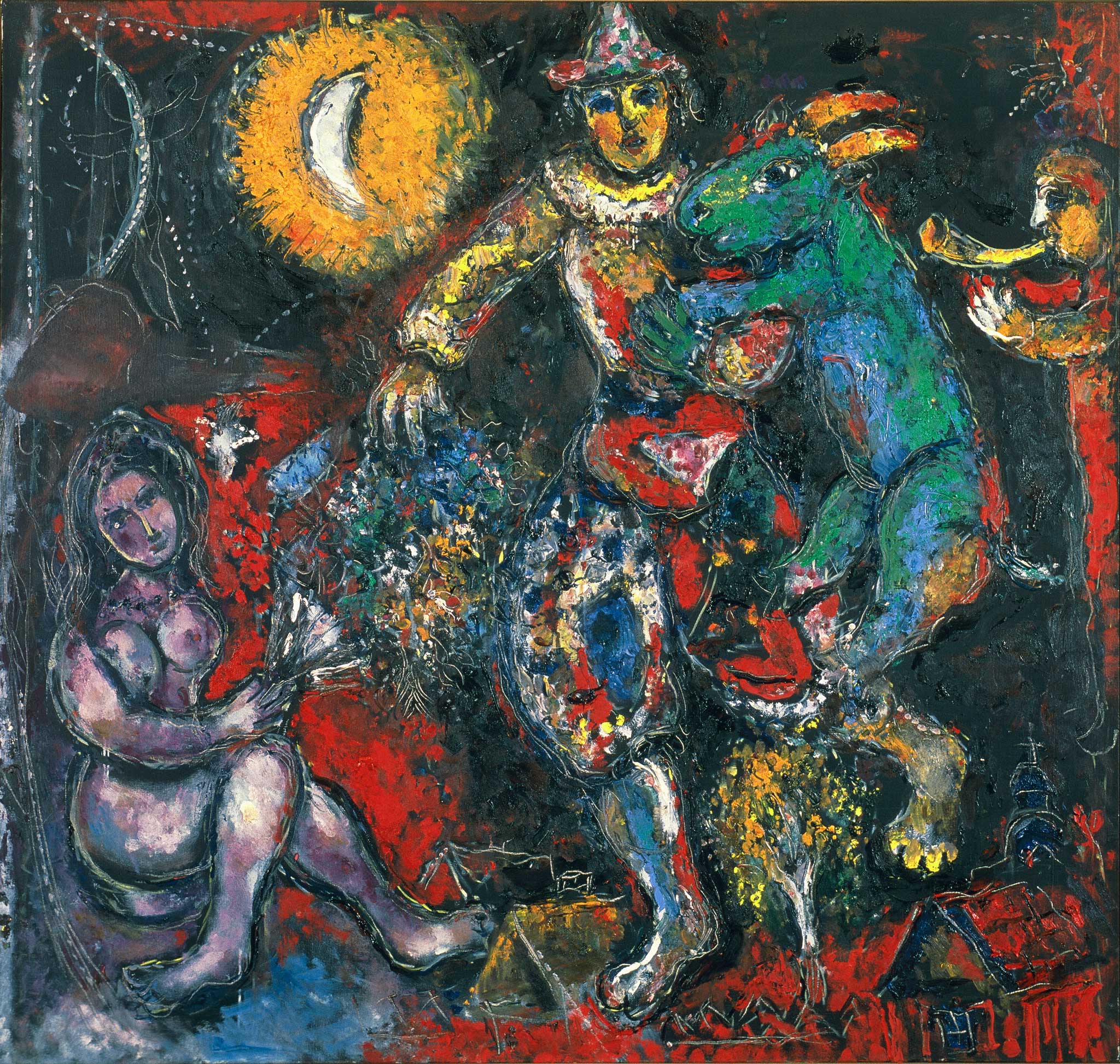Great works: Mauve Nude, By Marc Chagall
Private collection

This late painting by Marc Chagall, made when he was in his 80th year, deserves to be stared at long and long. It resembles the fragmentation of stained glass in its jewel-like intensity. It appears to emerge, swimmingly, out of the dark near-enamelling of its ground, as if from some dream-like pool. Some of the paint strokes look and feel like shards of splintered mosaic. Chronologically, it is the very last painting in the Chagall retrospective that is currently on view at Tate Liverpool, and it alone justifies a trip to the banks of the Mersey.
It is an old man's painting possessed of a young man's visionary eye gleam, larger than much of Chagall's early work and almost square. It comes at you: the paint almost crackles with a roaring exuberance. The brush work is a furious battle ground – there are scratchings of the surface, fierce, smudgy dabbings of brute colour, gentle surface stipplings. W B Yeats, in a late, great poem called "The Circus Animals' Desertion" asked, with just a smidgen of self-regardingly histrionic mock self-pity, "What can I but enumerate old themes?" Chagall might have asked himself that same question as he made this work – except that, in Chagall's case, matters are complicated by the fact that he had always, lifelong, been in the business of enumerating old themes, whether they be visual re-workings of Hasidic folk tales or evocations of his childhood in Vitebsk.
And here he goes again, layering and layering, as he builds up this mysterious nocturnal scene, peopled by a roof-stepping harlequin, that voluptuous, bouquet-flourishing mauve nude of the painting's title whose manner of representation owes much to the twin influences of Picasso and Matisse (Chagall spent some crucial formative early years in Paris, and the second part of his life in the south of France), roof tops (complete with the dome of an Orthodox church) painted, as so often, slightly vertiginously that recall his many scenes incorporating the buildings of Vitebsk, a horn player rasping out the food of love, a blazing white moon that emerges from a flaring circle of radiant orange, a tree that bursts upward into life from between the roof tops like a firework. And, last but scarcely least – perhaps most – that chubbily lovable leaping goat, which links up with all the other animals that Chagall painted with such tenderness throughout his life – goats, asses, pigs, horses and all the rest, as if to emphasise the mystical unity of all creation.
Everything is held together in the picture space, as if suspended, weightlessly, on air. The painting, we feel, is a drawing together, a phantasmagoric distillation, a species of inward reverie made suddenly manifest that joins hand with other moon-struck reveries by this same artist – except that this time there is no prone poet. There are other influences at work here too – that of Georges Rouault, for example, the painter of Christian scenes, who also dealt in the emergence of rich and furious colour from dark grounds, usually black as here.
As a colourist, there were few equals, as Picasso recognised when he once remarked: "When Matisse dies, Chagall will be the only painter left who understands what colour really is." There is nothing pre-meditated about Chagall's use of colour. It is wildly instinctive and intuitive. He uses it, always, with an extraordinarily forceful and energetic confidence. Look at that marvellous leaping goat, for example. See how many colours it is infected with as it leaps into the outspread arms of the harlequin, from the raging, flame-like hues of its twin horns to the yellow tips of its hooves.
And, in between, there is that astonishing choice of body colour, a thickly impastoed turquoisey, greeny, bluey blend. And one or two others too for good measure. Why deny any colour a seat at this feast?
This painting is currently on show in Chagall: Modern Master, Tate Liverpool (0151 702 7400) to 6 October
About the artist: Marc Chagall (1887-1985)
Born Moishe Segal, Marc Chagall, one of nine children, came from a family of Lithuanian Jews in Liozna, near Vitebsk, which is now in Belarus. His pious father worked for a herring merchant – "hellish work, the work of a gallery slave", his son once wrote – and his mother sold groceries from the family home. In spite of the fact that he often lived far from his native land – he spent the war years in America, and the last decades of his life in the south of France – his work circled, lifelong, around his Jewish heritage.
Join our commenting forum
Join thought-provoking conversations, follow other Independent readers and see their replies
Comments